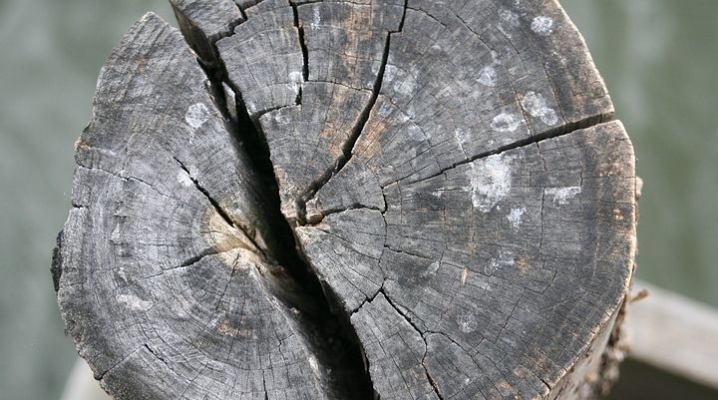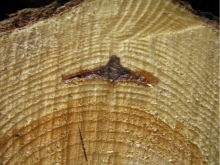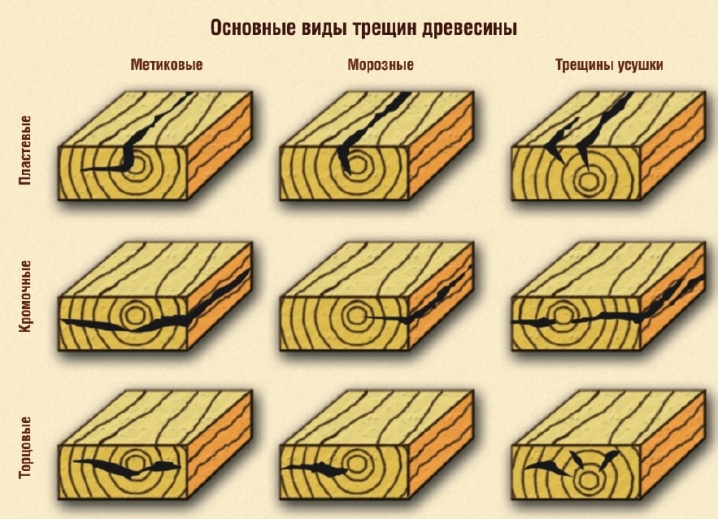All about the vices of wood

Wood is never perfect - it is a natural material, and it can have certain defects that arise naturally. Various knots, accumulations of resin and other similar phenomena do not harm the tree itself, but are considered unacceptable in the selection of raw materials for production. In addition, more serious damage, such as cracks or fungi, can render the material virtually unusable.

What it is?
Wood flaws are considered to be structural features and properties that limit the range of use of the trunk and its individual parts. Deviations can appear naturally, during growth, due to natural factors, as well as due to improper harvesting, processing or storage of the material. Some types of defects are unacceptable only for aesthetic reasons, but do not affect the mechanical properties. For example, healthy light knots will even seem beautiful to someone, because this is a natural structure.
but the standard may find them unacceptable in one assortment group, but perfectly acceptable in another. All existing defects are described by GOST. Document number 2140–81 defines how defects are measured, how they are classified, and the terminology used.

The standard takes into account quality problems and aesthetic deficiencies that do not impede operation.
What structural defects are especially common?
Some visible deviations are very common, many trees have them. Most of them relate to natural defects that occur in nature, and not due to disturbances in processing.
- The slope of the fibers. It can be radial and tangential. This problem is expressed in the mismatch of the direction of the vessels of the trunk and the main longitudinal axis. The cause of the appearance may also be an incorrect cut of a straight-layered workpiece. This defect to a certain extent reduces strength, increases overall shrinkage rates, and leads to further warping. Also, the material's ability to bend is reduced, resulting in processing difficulties.
- Roll. Layering in the knot area is disturbed, stripes and noticeable spots pass through the annual rings. This defect is typical for coniferous types. It can be seen on log cuts or blanks for any products. Formed in the compressed area of inclined or bent trunks. Roll reduces the cellulose content of the material by 10%.
- Pulling wood. Annual increments are expanding significantly. Changes can be found in deciduous trees, they are especially noticeable in species with clear rings - ash, oak. This problem makes machining difficult, and the fibers break off and get stuck when cuts are needed.
- Curliness. The wood fibers are disordered and the structure looks chaotic. The problem is especially typical for the lower part of the trunks of larch trees. Most often this is a local defect, but sometimes it can also extend along the entire length, for example, in Karelian birches. A deviation of this kind reduces the tensile resistance, increases the complexity of processing, but creates a beautiful structure, therefore it is considered a conditional flaw.Such material is in demand for decorative purposes.
- Grits and pockets. These are areas filled with resin or gum. They can be located between rings or vessels. They look darker than the surrounding wood.
- Dry bone. The section of the trunk may die out for some reason. In the dried part, you can see growths along the edges, which distinguish it from the general background. It will also appear to be depressed inward.
- Eyes. Sometimes buds do not develop into new shoots, but remain in their infancy. The eyes can be located quite far from each other or in groups. They also differ in color upon visual inspection - they are dark and light. Defects reduce flexural strength and negatively affect toughness.
- Spotting. Various streaks, lines in the structure, which do not affect the overall strength of the material. Typical for hardwoods. Although the mechanical properties are not severely affected, it can lead to cracking of the veneer if the stains are large.



Main barrel shape defects
There are problems that, to some extent, can complicate the harvesting of lumber. These are natural flaws that appear as the trunk grows. They increase the amount of all kinds of waste generated when cutting. Also, due to curvatures during growth, the fibers acquire a radial tilt, which is considered a disadvantage.
- Discretion. This is the name of the reduction of the trunk from the bottom to the top. The phenomenon itself is quite normal, but if the difference in diameter is more than a centimeter every meter, then this will already be considered a defect. They also distinguish between a subspecies of tightness - tightness. It is characterized by a very wide lower part compared to the rest of the barrel.
- Ovality. Elliptical ends are a disadvantage. Together with this problem, roll is usually found, which is one of the serious defects.
- Growths. These are local thickenings that can be smooth in structure or rough and bumpy. The reason for their appearance is bacteria, mechanical damage, fungal infections and other factors that lead to growth disorders. The formations can be very small (the size of a fist) or reach a weight of hundreds of kilograms - such giants are most often found on birches and walnut trees.
- Curvature. The barrel bends in length, making it difficult to handle. This problem occurs in all species, but some are less susceptible to it, for example, spruce, fir, oak, poplar. Curvature can be simple (with one bend) and complex (with several).


What are the cracks?
This defect is a lesion that runs parallel to the growth of the fibers. It is one of the main reasons for downgrading sawn timber. Cracks significantly reduce the strength of the wood and the ability to withstand heavy loads.

Also, their presence increases the likelihood of moisture, mold and mildew penetration into the wood. There is a classification of cracks, they can be divided into:
- deep (more than 1/10 of the trunk end diameter, exceeding 7 cm) and shallow (anything less than these parameters);
- closed (no more than 1 mm in width) and dispersed (may be wider than specified);
- end and side - the name indicates the location of the defect;
- through - look like holes visible from both sides.

There are also metic cracks - they run radially from the center of the trunk. They are especially common among pines and larch trees. The length can be up to 10 meters or more. In large timber, they can be seen only at the ends. Similar disadvantages arise during the growth of a tree, but they can also appear mechanically - when felling and hitting the ground.
As the material dries, the cracks increase in size.

Frost damage extends from the sapwood to the core, appearing from a sharp temperature drop during the cold season. They are typical for deciduous varieties, while in conifers they are less common. Outwardly, they look like traces of lightning strikes. Often there are ridges along the edges and significantly overgrown bark.
Sharp cracks appear between the growth rings. The occurrence of problems of this kind can be directly related to decay or the appearance of a water layer. Also, such defects are formed in areas of abrupt transition between layers.
Shrinkage cracks appear from internal stress. They diverge from the sides, then rush inward, following radial lines. They are usually smaller in size and depth than metic and frosty ones. May also appear due to uneven drying of products.

Overview of the types of knots on the trunk
All existing varieties can be divided into categories according to certain criteria:
- at the exit point - at the end, in the edge, in the rib or in the thickness of the lumber;
- as a bitch - he can be healthy or already affected (rotten, rotten, tobacco);
- in shape - oval, round, oblong and elongated in cross section;
- by location - single or group;
- by the type of exit - through, overgrown, one-sided.

Knots are a very common vice. Their number is directly related to growth conditions. Shade-tolerant breeds have more knots, as well as freely growing specimens. In addition, the number of defects increases closer to the top of the trunk. The effect of knots on specific mechanical properties of a material depends on the characteristics of a particular defect, its location in space, size and general condition.
Healthy round specimens deliver the least problems, but stitched and group ones are considered a more serious drawback.

Description of other defects
It is possible to identify secondary problems that in some cases make machining difficult. These disadvantages can be natural, and also arise from improper harvesting of timber or during storage in improper conditions.
Chemical paints
In the process of processing, you can find areas of wood that are significantly different in shade from others. Abnormal coloration occurs due to oxidation of tannins. Usually such zones are found at a depth of 1-5 mm, in the surface layers. Although the shade changes, this does not in any way affect the significant mechanical properties. Moreover, as the stains dry, they gradually fade, therefore, from an aesthetic point of view, the defect can be considered insignificant.

Warpedness
Warping is a change in the shape of the lumber. They can bend, twist, wave. The problem arises from improper and uneven drying, which creates internal stress. Deformation can proceed in different ways:
- tangentially, in the direction of the annual rings;
- longitudinally - parallel to the fibers;
- radially - along the medullary rays.

The warped material becomes unusable in one piece. In addition to the irregular shape, residual stress also remains inside, even after complete drying.
From pests and diseases
Biological factors are quite varied. These include insects as well as fungal diseases that affect trees. Problems can arise when storage technology is violated. Beetles, termites and larvae reproduce rapidly at a temperature of + 18-20 degrees and a humidity of 60-80%. They leave wormholes by making multiple passages in the wood.


With a large number of such damage, the material becomes rotten and unusable. Wormholes are shallow, medium, and deep, and some of them can go right through. Such defects reduce the strength of the lumber. Besides insects, there are other pests. On the trunks, you can find hollows left by birds, damage to the bark.
Some parasitic plants also negatively affect the condition of the wood.
Fungal lesions are divided into two types:
- destructive - they feed on lignin or cellulose, gradually corrode the cellular structure;
- coloring - consume organic substances and secrete an enzyme that changes the shade of wood, while destroying it to a lesser extent than the first variety.

It is often possible to recognize the presence of a fungus by external signs. This is the appearance of mold, spots and stripes of an atypical color, rot, a changed color of sapwood. With severe damage, large cavities may appear in the trunk. Some defects are immediately visible on visual inspection, others can only be recognized during processing. To obtain more accurate information, technical means are used - X-ray, gamma-ray flaw detection, acoustic method, photoelectric testing.













The comment was sent successfully.